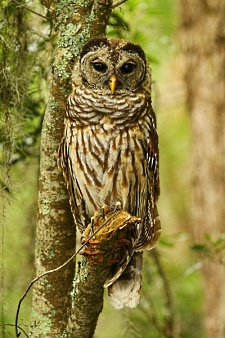Wildlife - Species

Barred Owl (Strix varia)
Description
The barred owl is one of 18 species in two genera of wood owls, family Strigidae. Also known as the "Hoot Owl," the barred owl is one of the most common owls in North America. It is a large (40-60 cm or 16-24 in) owl similar in appearance to the great horned owl, except for its lack of ear tufts. Its plumage is olive-brown above with off-white cross bars and spots. Brown crescent-shaped bars are distinct against the pale chest, and its belly has brown longitudinal streaks. The barred owl's face is pale with concentric circles near the margin of the facial disk. Its eyes are dark brown, almost black, and are set close together. Like many owls, the barred owl has asymmetrical ears; not only is one ear bigger than the other, they are also at different positions on the bird's head. This is an adaptation that enables owls to pinpoint the exact location of an object (i.e., prey) by the minute differences in sound that the brain receives from each ear.
Preferred Habitat and Biology
The barred owl is a resident from British Columbia east to Nova Scotia, and south to northern California and the Gulf Coast states. It occurs in thick lowland forests and swampy areas such as those in the ACE Basin. This owl hunts in open country; however, since it swoops down from a perch to capture prey, large open spaces are not required.
The barred owl's distinct call may be heard early in the spring, when breeding season begins. Nesting takes place in an unlined cavity of a hollow tree or in the abandoned nest of a crow, hawk, or squirrel. Sometimes a suitable tree cavity may be used by generations of owls over many years. Two to five white eggs are laid over 2-3 days. The female incubates one egg at a time, starting with the one that was laid first. Thus, chicks hatch in succession after an incubation period of 28 days. The female remains in nest for 3 weeks after the chicks have hatched. Parental care extends beyond 4 months, with chicks finally leaving the nest in the fall. The barred owl is nocturnal, although it may hunt in the daytime during overcast conditions. It can see extremely well, even under low light conditions, and can pinpoint the location of prey by sound alone. Upon locating suitable prey, the owl dives feet first for the kill. However, the barred owl's feet are not very large, thus l limiting the size of prey it can capture. Its diet consists of a variety of rodents, birds, frogs, fish, and crayfish.
Species Significance
Currently, the biggest threat to the species is loss of suitable nesting habitat. Because the barred owl is extremely sensitive to changes in size, age, and fragmentation of its forest surroundings, it serves as an indicator species, much like its cousin, the northern spotted owl, in the Pacific Northwest. The species is not currently endangered or threatened in South Carolina; in fact, it is common in most of North and South Carolina, except in areas of high elevation.
References
Bull, J. L. and J. Farrand, Jr. 1995. National Audubon Society Field Guide to North American Birds. Eastern Region. The Audubon Society field guide series. Alfred A. Knopf Inc., New York, NY.
Hume, R. 1991. Owls of the world. Running Press, Philadelphia, PA.
Sprunt, A., Jr. and E. B. Chamberlain. 1970. South Carolina bird life. University of South Carolina Press, Columbia, SC.
The Wilderness Society. 1998. Barred Owls prefer old forests. Wilderness and Science home page. http://www.wilderness.org/ccc/owls.htm. Accessed 30 April 1998.
